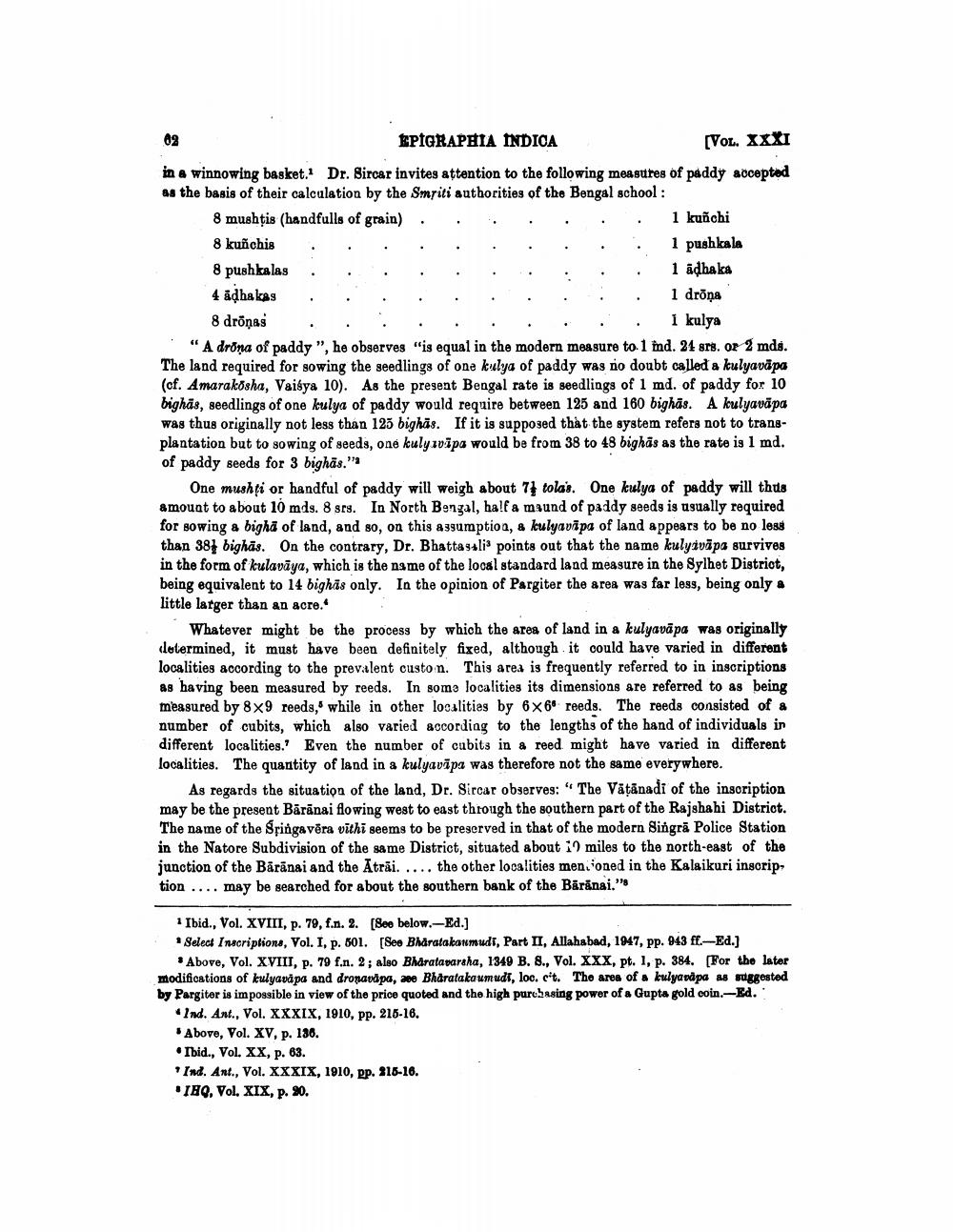________________
EPIGRAPHIA INDICA
[VOL. XXXI
in a winnowing basket. Dr. Sircar invites attention to the following measures of paddy accepted as the basis of their calculation by the Smriti authorities of the Bengal school :
8 mushtis (handfulls of grain) . . . . . . . 1 kuñchi 8 kuñchis . . . . . . . . . . 1 pushkala 8 pushkalas . . . . . . . . . 1 ādhaka 4 adhakas . . . . . . .
. . 1 droņa 8 dröņas . . . . . . . . . . i kulya "A drona of paddy ", he observes "is equal in the modern measure to 1 mnd. 24 srs. or 2 mds. The land required for sowing the seedlings of one kulya of paddy was no doubt called a kulyavāpa (cf. Amarakosha, Vaisya 10). As the present Bengal rate is seedlings of 1 md. of paddy for 10 bighās, seedlings of one kulya of paddy would require between 125 and 160 bighās. A kulyavāpa was thus originally not less than 125 bighās. If it is supposed that the system refers not to trangplantation but to sowing of seeds, one kulyavipa would be from 38 to 48 bighäs as the rate is 1 md. of paddy Beeds for 3 bighās."
One mushţi or handful of paddy will weigh about 7 tola's. One kulya of paddy will thus amount to about 10 mds. 8 srs. In North Bengal, half a maund of paddy seeds is usually required for sowing a bigha of land, and so on this assumption, & kulyavāpa of land appears to be no less than 387 bighas. On the contrary, Dr. Bhattasulis points out that the name kulyivāps survives in the form of kulavāya, which is the name of the local standard land measure in the Sylhet District, being equivalent to 14 bighis only. In the opinion of Pargiter the area was far less, being only a little larger than an acre.
Whatever might be the process by which the area of land in a kulyavāpa was originally determined, it must have been definitely fixed, although it could have varied in different localities according to the prevalent custo n. This area is frequently referred to in inscriptions as having been measured by reeds. In some localities its dimensions are referred to as being measured by 8 X 9 reeds, while in other localities by 6 x 66 reeds. The reeds consisted of a number of cubits, which also varied according to the lengths of the hand of individuals in different localities. Even the number of cubits in a reed might have varied in different localities. The quantity of land in a kulyavāpa was therefore not the same everywhere.
As regards the situation of the land, Dr. Sircar observes: "The Vāțānadi of the inscription may be the present Bārānai flowing west to east through the southern part of the Rajshahi District. The name of the Spingavēra vithi seems to be preserved in that of the modern Singrā Police Station in the Natore Subdivision of the same District, situated about 10 miles to the north-east of the junction of the Bärānai and the Atrāi. .... the other localities menioned in the Kalaikuri inscrip tion .... may be searched for about the southern bank of the Bärānai."
1 Ibid., Vol. XVIII, p. 79, f.n. 2. (See below.-Ed.] * Select Inscriptions, Vol. I, p. 601. (See Bharatakanmudi, Part II, Allahabad, 1947, pp. 943 ff.-Ed.]
. Above, Vol. XVIII, p. 79 f.n. 2; also Bharatavaraha, 1349 B. 8., Vol. XXX, pt. 1, p. 384. (For the later modifications of kulyavápa and dronavdpa, ace Bharatakaumudi, loc. e't. The area of a bulyardpa as suggested by Pargiter is impossible in view of the price quoted and the high purchasing power of a Gupta gold coin.-Ed.
Ind. Ant., Vol. XXXIX, 1910, pp. 215-16. Above, Vol. XV, p. 186. • Ibid., Vol. XX, p. 63. * Ind. Ant., Vol. XXXIX, 1910, pp. 916-16. IHQ, Vol. XIX, p. 90.




